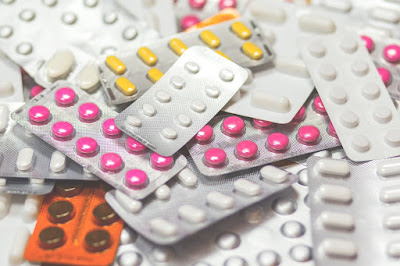It is an Extrapyramidal
motor disorder characterized by rigidity tremor and hypokinesia with secondary
manifestations like defective posture and gait masķ like face and sialorrhoea
dementia may accompany. If untreated the symptoms progress over several years
to end stage disease in which the patient is rigid unable to move unable to
breathe proprly succumbs mostly to chest infections/emobolism. Belladonna
alkaloids had been empirically used in PD.
CLASSIFICATION OF ANTI
PARKINSON DRUG
1. Drug affecting brain
dopaminergic system
A. Dopamine
precursor - Levodopa
B. Peripheral
decarboxylase inhibitors
1. Carbidopa
2. Benserazide
C. Dopaminergic agonists
1. Bromocriptine
2. Ropinirole
3. Pramipexole
D. MAO- B inhibitors
- Selegiline
E. COMT inhibitors
1. Entacapone
2. Tolcapone
F. Dopamine
facilitator - Amantadine
2. Drugs affecting brain
cholinergic system
A. Central anticholinergic
1. Trihexyphenidyl
2. Procyclidine
3. Biperiden
B. Antihistaminics
1. Orphenadrine
2. Promethazine
LEVODOPA
Levodopa has a specific
salutary effect in Parkinsons drug efficacy exceeding that of any other drug
used alone. It is inactive by itself but is the immediate precursor of
the transmitter DA.
ACTION
1. CNS
Levodopa hardly produces
any effect in normal individuals or in patients with other neurological
diseases. Marked symptomatic improvement occurs in parkinsonian patients.
Hypokinesia and rigidity resolve firtst later tremor as well. Secondary
symptoms of posture gait handwriting speech facial expression mood self care
and interest in life ate gradually normalized. Levodopa has been used to
produce a non specific awakening effect in hepatic coma.
2. CVS
The peripherally formed
DA can cause tachycardia by acting on beta adrenergic receptors. Though DA can
stimulate vascular adrenergic receptors as well rise in BP is not seen. Instead
postural hypotension is quite common. This may be a central action DA and NA
formed in the brain decrease sympathetic outflow also DA formed in autonomic
ganglia can impede ganglionic transmission.
3. CTZ
Dopaminergic receptors
are present in this area and DA acts an excitatory transmitter. The DA formed
peripherally gains access to the CTZ without hindrance elicits nausea and vomiting.
Tolerance occurs gradually to this action.
4. ENDOCRINE
DA act on pituitary
mammotropes to inhibit prolactin release and on somatotropes to increase GH
release. Though prolactin levels in blood fall during Levodopa therapy therapy
increased GH levels are not noted in parkinsonian patients. Probably the
mechanisms regulating GH.
PHARMACOKINETICS
Levodopa is rapidly
absorbed from the small intestines by utilizing the active transport process
meant for aromatic amino acids.
Bioavailability of
Levodopa is affected by:
Gastric emptying if slow
Levodopa is exposed to degrading enzymes present in gut wall and liver for a
longer time less is available to penetrate blood brain barrier.

0 comments:
Post a Comment